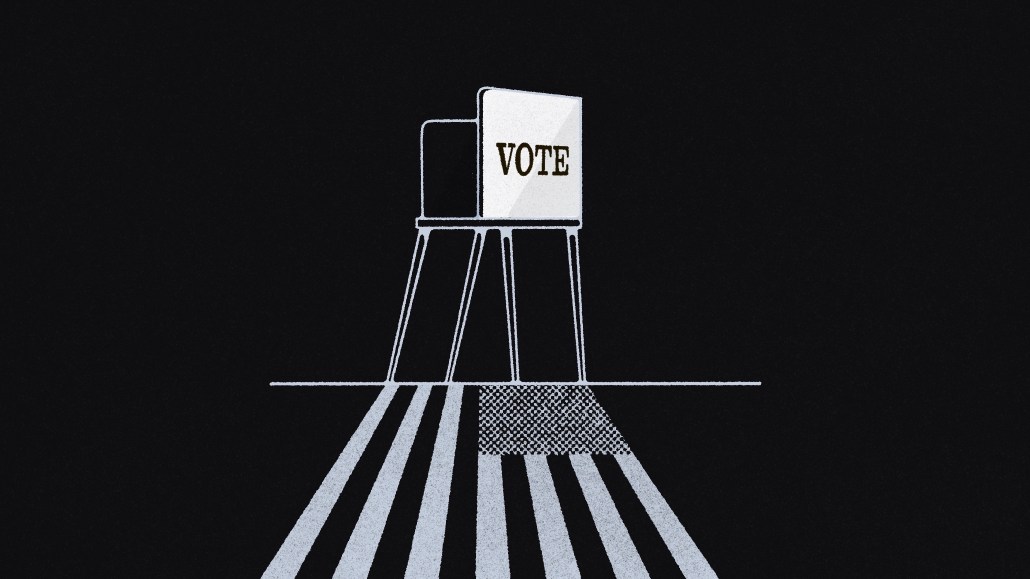Why Washington State is investing in a new kind of voter education campaign

As a Digiday+ member, you were able to access this article early through the Digiday+ Story Preview email. See other exclusives or manage your account.This article was provided as an exclusive preview for Digiday+ members, who were able to access it early. Check out the other features included with Digiday+ to help you stay ahead
Fifty years after Schoolhouse Rock introduced kids to “I’m Just a Bill,” Washington state has crafted a friendly new character to educate state voters on the serious issue of election security.
Ahead of the 2024 elections, a new marketing campaign in Washington state aims to bolster trust in voting systems. The $1.8 million campaign, paid for by the Washington Secretary of State’s office, goes beyond boosting voter turnout to explain mail-in voting and how the process is safe, secure and transparent.
The campaign, which launched last month, stars an animated ballot aptly named “Mark The Ballot.” Video ads show “Mark” happily explaining his route from the elections office to voter mailboxes to official drop-off points to where each is thoroughly verified and officially counted. The visuals strongly resemble the 1970s Schoolhouse Rock classic, which featured a bill named Bill explaining how Congress passes laws on Capitol Hill.
The strategy is a noteable shift from how Washington has communicated with voters in the past. In an interview with Digiday, Washington secretary of state Steve Hobbs said the state legislature saw a need to inform voters about how elections work, which also required election officials to learn more about voters’ current knowledge about the process.
While past communication was focused on reminding people to vote and where to mail or drop off their ballots, the latest efforts also address some of the false narratives related to protestors storming the U.S. Capitol and the Washington State Capitol on January 6, 2021. For example, people claimed voting machines were hacked but didn’t realize tabulation machines aren’t connected to the internet.
The new campaign also includes info about voter verification, how people can tour the election office to observe the process firsthand and the role of local volunteers that help keep elections safe and secure. It also provides people with details on where to go for accurate information at the local and state level.
“If you receive information and you don’t have anything to bounce it off of, you take it as truth,” Hobbs said. “That’s kind of our fault for not telling the public [how elections work], and we took it for granted. And unfortunately, some people have a different narrative for it, and then those false narratives were fanned by overseas malign actors, nation-state actors, who wanted to throw our elections.”
Washington’s efforts come amid concern about disinformation spread within the U.S. on various platforms. Other worries include AI-generated information not just spreading false information about candidates and voting systems, but also potentially misinforming people when and where they should vote. But rather than focus too much on addressing everything in real time, the campaign aims to help people find accurate and trusted information through the secretary of state’s office and local governments.
Last year, Washington passed a new law regulating the use of AI-generated political ads made including audio, image and video deepfakes. Political ads made with generative AI now require disclosures as synthetic media that must be shown during a video’s entirety. Hobbs said the challenge of fighting misinformation from various fronts to a rowboat with a hole being flooded with water.
“This has to be constant,” Hobbs said. “We cannot lay down on the job, because if the other side is attempting to sow distrust and misinformation, they will continue to do so. If we stopped on our end, then we’re losing. That water’s coming in and nobody’s bailing it out.”
The 2024 elections come amid a “perfect storm” making misinformation increasingly hard to track and combat, according to Vivian Schiller, executive director of Aspen Digital, part of the Aspen Institute. Factors include social media platforms reducing content moderation efforts, third-party experts facing fewer resources, and the rise of encrypted messaging apps.
“Washington state has always been way out ahead of everybody,” Schiller said. “They were the first to do all remote voting, so it’s great to see [this campaign]. I wish every state in the United States was doing [similar work] this year. It’s always been important for election administration offices to get the word out about accurate voting, but it’s more important than ever in this particular year.”
Washington’s campaign was created by Portland-based creative agency Happylucky, which previously did an election campaign with Oregon’s secretary of state’s office. For Washington, the concept has a “home grown feel” focused on local communities, according to Ben Hennes, Happylucky’s co-owner and chief creative officer. The messaging is also adaptable for various cities across the state to feature the people and places in each part to help people feel a sense of pride in voting as a community effort. He said the similarity to “I’m Just A Bill” is inspired by “a time where patriotism felt higher, where trust in government felt higher.”
“We wanted to bring some humor into this,” Hennes said. “Something that felt really human, that felt approachable and that was combating a lot of negative energy around voting misinformation with something that felt positive. We kind of see Mark as your go-to friend and confidant in navigating the Washington election system.”
The three-phase campaign began earlier this year with a social media campaign followed by a broader paid media campaign earlier this summer. Some of the paid media includes audio ads on Spotify, and collaborations with local radio DJs, print ads and paid out-of-home placements with the Seattle Seahawks. There’s also online short- and long-form video on YouTube and other online platforms.
A third phase still in the works will include partnerships with local colleges and athletes and other “local heroes,” said Hennes. The goal, he added, is to “equate the election system to those things within our local communities that we take pride in, as in this is something we’ve built together as a community over time, as a state over time.”
In a 2022 poll of Washington voters, 28% didn’t trust the state’s vote-by-mail system, according to a survey commissioned by several outlets including KING 5 News, The Seattle Times, the University of Washington and Washington State University. That creates a challenge for the state, which is one of several that rely mostly on mail-in votes. However, Happylucky’s preliminary research found that voting trust is higher for local elections than for state and national elections.
Washington’s just one example of the myriad efforts underway to better educate voters at the local, state and national level. Others include the National Association of Secretaries of State, which launched a “#TrustedInfo2024” initiative to inform people about election resources from state and local officials. First launched in November 2019, the updated campaign recently integrated its “CanIVote” website with Google Translate to make resources more accessible in various languages.
In May, the U.S. Election Assistance Commission highlighted dozens of election jurisdictions of varying size for their voter education efforts. Some of the EAC’s 2024 “Clearinghouse Awards” include education efforts in North Carolina, Colorado, Arizona and Florida.
One of the challenges with election communication is that election administration is chronically underfunded, according to EAC Chairman Ben Hovland told Digiday. Since 2018, Congress has provided the EAC with nearly $1 billion in funding to distribute across the country for voter education, cybersecurity and tech, and other efforts. However, the funding for each year has gone from $380 million in 2018 and $425 million in 2020 to just $55 million in 2024.
“There’s the whack-a-mole of disinformation where you’re sort of always chasing down these conspiracies or rumors or things of that nature or there’s just providing trusted source information,” Hovland told Digiday. “Home base for election officials is focusing on that trusted source information, providing that accurate information about how elections are administered, how people can participate.”
More in Media Buying

As Integral Ad Science marks its fourth anniversary on the Nasdaq, speculation mounts over its future
Efforts are underway to take IAS private but there are varying levels of interest from private equity groups.

Media Buying Briefing: Two years later, media buyers still aren’t fully sold on The Trade Desk’s Kokai platform
Two years after its launch, The Trade Desk’s Kokai tool has acquired a mixed reputation among the agency media buyers it was designed for.

The Rundown: The regulatory hurdles still in the way of the Omnicom-IPG merger
British, Australian and EU regulators are all looking into mega agency merger.







